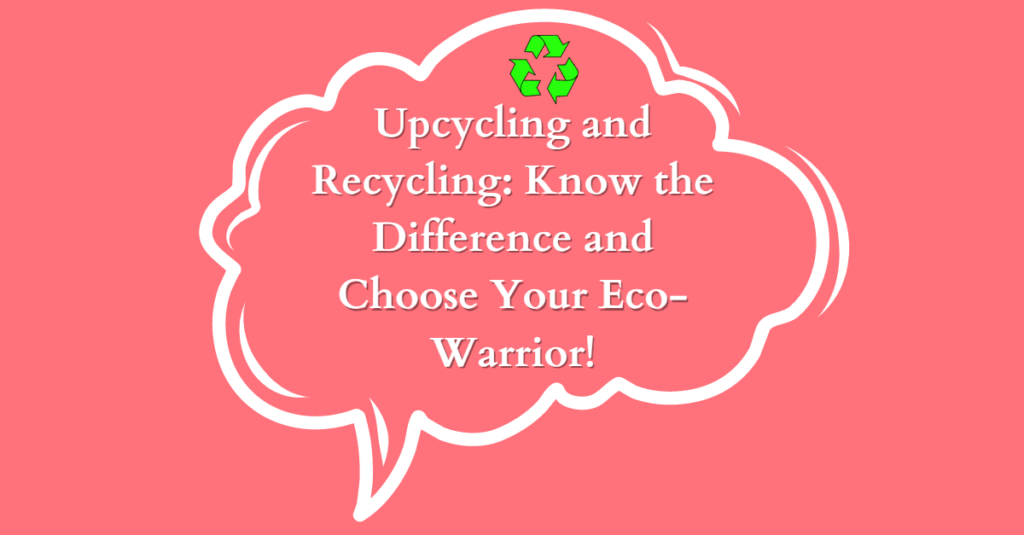Upcycling and Recycling: Know the Difference and Choose Your Eco-Warrior!
Introduction:
In a world grappling with environmental challenges, the concepts of upcycling and recycling have emerged as powerful strategies to combat waste and promote sustainability. While both approaches share the common goal of diverting materials from landfills, they differ in their methods and outcomes. Understanding the difference between upcycling and recycling empowers individuals to make informed choices and become eco-warriors in their own right.
Upcycling: Transforming Waste into Creative Possibilities
Upcycling is a creative and innovative approach to waste management. It involves taking discarded materials and transforming them into new, valuable, and functional products. Unlike traditional recycling, which breaks down materials into raw components for the creation of new products, upcycling repurposes existing materials in their current form. This process not only reduces waste but also adds value to the discarded items by giving them a new life.
The beauty of upcycling lies in its ability to unleash creativity and imagination. Artists, designers, and DIY enthusiasts often use upcycling to create unique and one-of-a-kind pieces. For example, an old wooden pallet can be transformed into a stylish coffee table, or a discarded mason jar can be turned into a trendy pendant light fixture. Upcycling not only reduces waste but also showcases the potential of overlooked materials and encourages us to see the beauty in what was once considered trash.
Recycling: Closing the Loop for Resource Conservation
Recycling, on the other hand, focuses on breaking down materials and converting them into new products. It involves collecting, sorting, and processing waste materials such as paper, plastic, glass, and metal to create raw materials that can be used in manufacturing. Recycling helps conserve resources by reducing the demand for virgin materials, thus lessening the need for resource extraction.
The process of recycling varies depending on the material. For instance, paper is often recycled by pulping it and turning it into new paper products. Plastic bottles can be broken down into pellets that are melted and molded into new plastic items. Aluminum cans are shredded and melted to create aluminum sheets for manufacturing purposes. Recycling not only saves valuable resources but also reduces energy consumption and greenhouse gas emissions associated with the production of new materials.
The Difference between Upcycling and Recycling:
- Definition: Upcycling focuses on creatively repurposing and redesigning discarded materials to give them a new life and purpose. It involves transforming the materials into something different and often more desirable. Recycling, on the other hand, aims to recover the raw materials from waste products to manufacture new products, reducing the need for virgin materials.
- Purpose: Upcycling seeks to add value and transform discarded items, finding alternative uses and creative ways to repurpose them. It emphasizes breathing new life into materials and giving them a second chance. Recycling, on the other hand, aims to recover and reuse the raw materials from waste products, reducing the demand for new materials and minimizing resource depletion.
- Complexity: Upcycling often requires creative thinking, craftsmanship, and artistic skills. It involves a hands-on approach that encourages individuals to use their creativity to transform materials. Recycling, on the other hand, involves industrial processes and technologies to collect, sort, and process waste materials on a larger scale.
- Material Transformation: Upcycling allows the original materials to retain their identity and form, but they are transformed or repurposed into new products. For example, turning old glass bottles into decorative lamps or transforming wooden pallets into furniture. Recycling, on the other hand, breaks down materials and transforms them into raw materials that can be used to manufacture entirely new products. For instance, plastic bottles are shredded and melted down to produce plastic pellets used in the production of new plastic products.
Choosing Your Eco-Warrior: Factors to Consider
When deciding between upcycling and recycling, there are several factors to consider. The first is the condition of the materials. Upcycling works best with items that are still in good condition but no longer serve their original purpose. It allows for creative freedom and personal expression, turning discarded items into unique and functional creations. Recycling, on the other hand, is ideal for materials that have reached the end of their usable life and need to be transformed into new products.
The second factor to consider is the environmental impact. Upcycling often requires minimal energy and resources since it repurposes existing materials without the need for complex manufacturing processes. It helps reduce carbon emissions and waste generation. On the other hand, recycling requires more energy and resources for the collection, sorting, and processing of materials. However, it still significantly reduces the environmental impact compared to producing new materials from scratch.
Another consideration is the scalability and infrastructure required. Upcycling can be done on an individual level or in small-scale community projects, making it accessible to anyone with creativity and a willingness to repurpose. Recycling, on the other hand, often relies on well-established collection systems, sorting facilities, and recycling plants. It requires the participation of individuals, businesses, and governments to create an effective recycling infrastructure.
The Power of Collaboration: Combining Upcycling and Recycling
Rather than viewing upcycling and recycling as mutually exclusive approaches, we can harness the power of collaboration between the two. By incorporating upcycled materials into the recycling process, we can create a more circular and sustainable system. For example, recycled plastic can be used to create new products, and upcycled fabric can be incorporated into the production of recycled textiles. This combination allows us to maximize resource conservation, minimize waste, and promote creative sustainability.
Making a Difference as an Eco-Warrior
Whether you choose to be an upcycler, a recycler, or a combination of both, you play a vital role in the journey toward a greener future. By embracing upcycling and recycling practices, you reduce waste, conserve resources, and contribute to a more sustainable society. Here are some steps you can take to become an eco-warrior:
- Embrace a mindset of conscious consumption. Reduce your reliance on single-use items and opt for reusable alternatives.
- Practice responsible recycling. Sort your waste properly and support local recycling initiatives to ensure that materials are processed correctly.
- Explore your creativity through upcycling. Repurpose items you no longer use into new and functional products. Share your creations with others and inspire them to do the same.
- Educate and advocate. Raise awareness about the importance of upcycling and recycling in your community. Encourage others to adopt sustainable practices and support initiatives that promote a circular economy.
Conclusion:
In conclusion, upcycling and recycling are both valuable practices in the journey towards a sustainable future. Upcycling allows us to creatively repurpose materials, while recycling conserves resources and reduces waste. By understanding their differences and collaborating between the two, we can make a significant impact. As eco-warriors, we have the power to make a difference by adopting these practices, advocating for sustainability, and inspiring others to join the movement. Together, we can create a greener and more sustainable world for generations to come.

My name is Rohit Vagh and I’m a content writer specializing in fashion and lifestyle. I have three years of experience in this field and have written various articles. My writing style is creative and engaging, and I strive to create content that resonates with my readers. I have a deep passion for fashion and am constantly researching the latest trends and styles to make sure my readers are up to date. I’m excited to continue my career in blogging, and I’m always looking for new opportunities in the fashion and lifestyle space.





